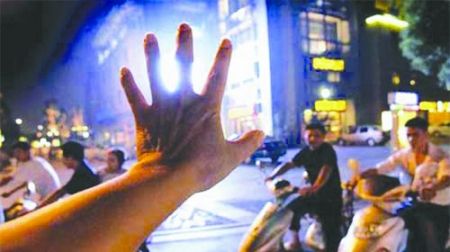1 light security classification
Generally light safety can be divided into the following two types, namely biosecurity and interference light.
Light biological safety
This type of security research include uv, ir, light blue and visible radiation on human tissue damage problem.The light of the common biological hazards are mainly photochemical ultraviolet harm to human body skin and eyes, blue light on the human body the harm of the retina, infrared laying the harm to the eyes and the impact of sunlight on the skin, and so on.
All sensory organs in the body, the eyes are the most important part of a, its ability to repair itself is relatively weak, once the external optical radiation will cause irreversible damage to the eyes, even if the visible light are likely to hurt people's eyes, such as shorter wavelength blue light can cause retinal photoreceptor cell damage, serious when can cause pigment epithelial function degradation, and like a high strength of irradiation can lead to thermal damage of retina.
Interfere with the light
Interference can be divided into direct and indirect light two kinds, the former is to point to specific vision brightness higher light directly cause the loss of visual resolution:The latter refers to the light did not directly appear within the field of vision, but after an object's surface reflection light projection into the problems of the human eye.
Through investigating the domestic some LED display manufacturers and found that the maximum brightness of LED display in 6 ~ 8 000 000 CD/m2, the numerical didn't reach the light brightness lowest biosafety problems, therefore, LED display is not including the blue light damage to the retina, light biological hazards.In view of this, the key to the problem of the interference of LED display light is analyzed.
The reasons for the formation of 2 LED display light interference
Their own reasons
LED display has the characteristics of high brightness, if the brightness of the display screen on a dark night output reached 8000 CD/m2, it can cause serious light interference.
Position reason
Observer the closer the distance of the screen, or the standing position and display form on the edge, the greater the gaze direction toward the convergence, the screen or observer will produce more serious interference of the light.
Illumination reasons
Day and night environment illumination exists obvious difference, this will cause the same brightness LED display in different period of time will produce different degree of interference of light.
Observer reason
Observer of the age, occupation, health, psychological mood different, will feel different levels of interference of light.For example, often contact photosensitizer or observer with eye diseases, to be more sensitive to light.
Content according to reason
If a screen shown in the image content changes too fast, easy cause discomfort observer;High brightness, color transition stiff, can also cause eye discomfort.
Evaluation standard for
Displays are used in many places, such as road traffic, commercial, residential areas, because of the different nature of place, the interference of light evaluation standard is also different.
Environmental reasons
Environmental conditions can significantly influence on the display screen interference light, if the environment condition is relatively poor, such as the fog haze, dust, fog, rain, wind and other weather, will affect people's judgment to display light interference, the human eye under the affected by external factors, will cause the judgment standard, the objectivity of impact assessment.

LED display light pollution problem solution
High brightness characteristics of the LED display is the most important reason to produce light pollution, in order to effectively solve the problem of light pollution, can adopt the following safety protection methods.
1 based on environment brightness adjustment
Adjust the human eye comfortable brightness
According to display in the degree of environmental light intensity, to adjust the overall brightness of LED display in screen resolution at the same time, avoid to produce dazzling, poor visual perception.Through investigation and study showed that if the environment of the human eye habits 800 CD/m2 brightness, then the human eye can see the brightness of the 80-8, 000 CD/m2, if beyond the brightness of the scale, the human must be recuperated after a few seconds to see step by step.So, adjust the brightness LED display depends on environment, the introduction of environmental brightness monitoring equipment, provide reliable basis for brightness adjustment, make the screen brightness to adjust to the human eye comfortable viewing range.During the night, the brightness of the display screen should be controlled below the environment brightness 10 times.
Standard for brightness adjustment
Many outdoor display screen to the brightness of the night is too high, caused serious light pollution, to a certain extent influence to surrounding residents life.Introduced for this purpose, the relevant departments shall display brightness adjustment standards, strengthen the prevention and control of light pollution, request to display units must be based on environment brightness actively adjust brightness output, output high brightness light forbidden in the dark night.
2 blue light output cuts
Different wavelengths of light on the human eye can bring different visual perception, due to the human eye perception has a certain complexity, it is difficult to through the brightness of this measure to reflect the human eye perception of light, so the exposure index, can be introduced as a judge energy range of visible light safety standards.In measuring light effect on the human eye, not only by the human eye to the brightness of the blue light feeling, but to the introduction of irradiance measurement equipment, metering equipment with measured data to objectively reflect the blue light output intensity of the impact on the visual perception.LED display manufacturers to ensure display shows the function, on the basis of appropriate cut blue light output, so as to avoid damage to the human eye discomfort.
3 control light spread
